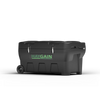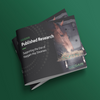We often discuss the effects of the stable environment on the health of our horses, but we shouldn’t overlook the fact we spend a lot of time in the same environment whilst caring for our horses.
There are relatively few published studies on the prevalence of respiratory problems in humans working with horses than in horses themselves but Gosling (2014) investigated this and found 1 in 4 people who work with horses have a respiratory condition. The incidence of respiratory diseases was related to stable management activities particularly feeding dry hay and filling hay nets. In addition, studies in conventional stables have shown that recommended levels of endotoxin, which may cause inflammation in human airways, are often exceeded (McGorum et al 1998).
This was highlighted again recently when Emily Boyce a final year equine studies student at The Royal Agricultural University (UK) posted a picture on Facebook of a mask she had worn while filling hay nets. The picture shows the mask covered in dust and received hundreds of comments. Horse and Hound magazine have reported on the story and since then hundreds more comments have been received from horse owners sharing their experiences and illnesses caused by dust from hay, straw and the general stable environment.
Here are some of the Facebook comments:
“I developed Aspergillosis (in a sphenoid sinus) as a result of handling haylage. I needed an operation to remove it, I had horrible symptoms and was very lucky it did not spread as it can be fatal. I was otherwise healthy and it is rare but not unheard of in people who are not immunocompromised. I was recommended to wear the highest level dust mask after that.”
“I wear a mask, one with filters, and they last about 10 days doing nets for just 3 horses. I've had 2 attacks of what would appear to be ' 'farmers fever' similar to farmers lung before wearing a mask.”
“I’ve filled hay nets and mucked out for 45 years and can hardly breathe now”
“I have to wear a mask to load hay nets or move bales. I have asthma attack’s otherwise, and develop a nasty hacking cough that stays for weeks.”
“I was recently diagnosed with Asthma, that my Doctor said was dust induced. I was told to wear a mask when doing haynets and mucking out.”
 People working in and visiting horse stables are exposed to the effects of the stable air. Causes of chronic airway disease both in horses and humans usually involve exposure to excessive concentrations of airborne dust, moulds, viruses, bacteria, spores, aeroallergens, and endotoxins which mostly originate from bedding and feed (Berndt et al 2010). The inhalation of gaseous irritants such as ammonia by bacteria from urine may initiate airway obstruction and exacerbate or prolong the clinical signs of asthma in both horses and humans.
People working in and visiting horse stables are exposed to the effects of the stable air. Causes of chronic airway disease both in horses and humans usually involve exposure to excessive concentrations of airborne dust, moulds, viruses, bacteria, spores, aeroallergens, and endotoxins which mostly originate from bedding and feed (Berndt et al 2010). The inhalation of gaseous irritants such as ammonia by bacteria from urine may initiate airway obstruction and exacerbate or prolong the clinical signs of asthma in both horses and humans.
What you can’t see happening
When a person breathes in, particles suspended in the air enter the nose. The nose is an efficient filter, most large particles are stopped in it and removed mechanically by blowing the nose or sneezing.
Some of the smaller particles succeed in passing through the nose to reach the windpipe, bronchi and bronchioles which lead to the lungs. These airways are lined by cells that produce mucus to catch dust particles. Tiny finger-like projections called cilia, covering the walls of the air tubes, move the mucus upward and out into the throat, where it is either coughed up and spat out, or swallowed.
The air reaches the alveoli, tiny air sacs in the inner part of the lungs with any dust particles that avoided the defences in the nose and airways. The air sacs are very important because through them, the body receives oxygen and releases carbon dioxide.
Dust that reaches the sacs and the lower part of the airways where there are no cilia is attacked by cells called macrophages. These are extremely important for the defence of the lungs. They keep the air sacs clean. Macrophages virtually swallow the particles. Then the macrophages, in a way which is not well understood, reach the part of the airways that is covered by cilia. The wavelike motions of the cilia move the macrophages which contain dust to the throat, where they are spat out or swallowed.
Besides macrophages, the lungs have another system for the removal of dust. The lungs can react to the presence of germ-bearing particles by producing certain proteins. These proteins attach to particles to neutralize them.
Similar to the horse, the way the respiratory system responds to inhaled particles depends, to a great extent, on where the particle settles. For example, irritant dust that settles in the nose may lead to rhinitis, an inflammation of the mucous membrane. If the particle attacks the larger air passages, inflammation of the trachea (tracheitis) or the bronchi (bronchitis) may be seen.
The most significant reactions of the lung occur in the deepest parts of the lung.
Particles that evade elimination in the nose or throat tend to settle in the sacs or close to the end of the airways. But if the amount of dust is large, the macrophage system may fail. Dust particles and dust-containing macrophages collect in the lung tissues, causing injury to the lungs, fibrous tissue forms and scarring (fibrosis) can occur.
Aside from the vegetable or animal component, organic dusts can contain fungi or microbes and the toxic substances given off by microbes.
Farmers Lung
Dust containing spores from two types of bacteria, "Micropolyspora faeni" and "Thermoactinomyces vulgaris", and certain types of moulds called "Aspergillus" are the major causes of Farmer's Lung and the same species that are implicated in the development of equine asthma. The spores are not infectious, instead, they trigger an allergic reaction.
Farmer's Lung develops in two steps, as other allergic reactions do. The first time a person inhales a large amount of dust and spores from mouldy hay, the immune system often responds by producing specific antibodies against the antigens. Antibodies are chemicals that circulate in the blood and attack specific antigens. Once the body has produced these antibodies, there is a chance that further exposure to mouldy dust can generate a hypersensitive type of allergic reaction. This reaction is typical of Farmer's Lung.
A hypersensitive reaction is triggered when antigens in the lungs react with antibodies that circulate in the blood; this sets off a complicated reaction normally intended to protect the lungs from infections. Certain types of white blood cells move into the lungs to attack the antigens. Then, other types of white blood cells move into the lungs, releasing chemicals and poisons that increase blood flow and kill lung tissue close to the antigens. This response causes swelling, inflammation and damage to lung tissue, resulting in noticeable breathing problems.
The Health and Safety Executive (HSE) website states farmers lung is the most common occupational form of extrinsic allergic alveolitis – which refers to a group of lung diseases that can develop after exposure to certain substances. During handling of mouldy straw, hay or grain, particularly in a confined space such as a poorly ventilated building, inhalation of spores and other antigenic material is very likely. The HSE advises respiratory protection should be worn.
How to improve stable air quality
Anecdotal reports suggest that Equine Asthma is rare in climates where animals are outside all year around but common in climates where horses are stabled indoors (Derksen, 1991).
It’s clear we need to improve the air quality in our stables for both our horses health as well as our own. Minimizing dust in the stable is a holistic approach, look at ways you can improve the ventilation, step up your cleaning protocols, hoover up the dust and curtail your sweeping!
Steaming forage using Haygain hay steamers reduces respirable dust particles by up to 99% so once steamed it is safe to handle. The HG2000 can be used with fully strung bales resulting in minimal dust disturbance.
ComfortStall flooring from Haygain is a stable flooring system that delivers better air quality in the stable. The impermeable sealed flooring creates a barrier so that urine cannot build up and form urea that in turn gives off ammonia. Up to 80% less bedding can be used on a Comfortstall flooring due to the comfortable padding which further reduces the dust present in the stable environment.
References:
Berndt, A.; Derksen, F.J.; Robinson, N.E. Endotoxin concentrations within the breathing zone of
horses are higher in stables than on pasture. Vet. J. 2010, 183, 54–57.
Curtis, L.; Raymond, S.; Clark, A. Dust and ammonia in horse stalls with different ventilation rates and bedding. International Journal of Aerobiology. Vol. 12, 239-247, 1996.
Derksen, F.J. Chronic Obstructive Pulmonary Disease. In Equine Respiratory Disorders; Beech, J., Ed.; Lea & Febiger: Malvern, PA, USA, 1991; pp. 223–235.
Gosling K (2014) The Prevalence of Human Respiratory Disorders in UK Equine Industry BSc Thesis, Royal Agricultural College, Cirencester, UK.
McGorum BC, Ellison J, Cullen RT: Total and respirable airborne dust endotoxin concentrations in three equine management systems. Equine Vet J 1998, 30: 430–434.
Saastamoinen, Markku & Särkijärvi, Susanna & Hyyppä, Seppo. (2015). Reducing Respiratory Health Risks to Horses and Workers: A Comparison of Two Stall Bedding Materials. Animals : an open access journal from MDPI. 5. 965-977. 10.3390/ani5040394.
http://www.hse.gov.uk




















